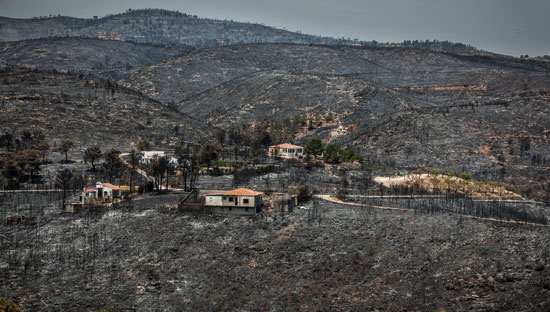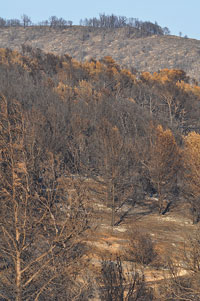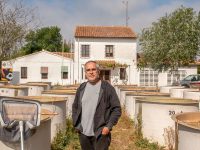
The end of 2012 knocks at our door and, according to provisional data from the Department of Agriculture, Food and Environment, we leave behind almost 200,000 hectares destroyed by fire throughout Spanish territory. The total number of fires and attempted arsons nears 15,000, although a good part of the burnt surface corresponds to about 40 big fires (each over 500 hectares). Nearly every region has been affected, with a special mention for the region of Valencia. Forest tragedy has been even worse because of the extremely painful consequences: ten people died because of them. It could be deemed probable taking into account two circumstances: on the one hand, the ones we could call «structural», linked to general environmental features of our land and to the inertias of forestry management; on the other hand, those other «contingent» ones, such as the last draught and the undeniable (whatever may be said on the contrary) decrease in resources dedicated to prevention and fighting against fire.
«From an ecological perspective, it is evident that fire is inherent to mediterranean forest ecosystems. We should learn to live with wildfires»
From an ecological perspective, it is evident that fire is inherent to mediterranean forest ecosystems. As Juli Pausas very well points, we should learn to live with wildfires. It is not an easy thing to say in a social environment that equals forest fires with disaster. Well then, a fire should not always be a disaster; not environmentally, nor socially. Let’s not forget that vegetation in our landscapes has evolved with fire as a day-to-day selective pressure. Meanwhile, human populations have developed uses for fire that were favorable for their survival. The problem starts when, because of exaggerated proportions, effects on degraded areas, serious destruction of goods and services and, especially, the risk of personal tragedy, fire automatically turns into a synonym for catastrophe. But fire, we need to say, is turned into a catastrophe by humans, with acts, attitudes and lifestyles that do not give it due consideration or use a biased approach.
Fire ecology and other branches of natural science have advanced a great deal these last years on the comprehension of wild fires. It was only 2011 when Mètode published a monographic on the topic. Now we know a lot more about the physical and biological dynamics that explain fires. However, the social dimension has been approached the same way, in my honest opinion. There is no doubt that a systemic approach is fundamental to understand the topic. The average person, nonetheless, has no conscious experience of his relationship with a forest or mountain in those terms. One can feel it according to utilization parameters; most usually it is on appreciation and landscape experience. Ecosystems and landscapes are obviously linked, but they are deeply different. Any correlative automatism is out of place. And it is on the landscape aspect –and thus, in the area of cultural constructions– where a great part of the shared reaction to fire is situated.

Macastre landscape at the beginning of July 2012, after the wildfire that affected several localities in the Hoya de Buñol. / Miguel Lorenzo
Fire generations
Last June 28th, the sparks generated by workers from a solar panel installation in a village near Cortes de Pallás (Cofrentes valley, Valencia) started a fire that, poked by the wind and favoured by dryness and high temperatures, quickly became dreadful in size. It ended up affecting over 28,000 hectares. The next day, a new accident, declared in Andilla (La Serranía, Valencia), its origin attributed to an agricultural field burning, took on the following days nearly 20,000 hectares. Smoke clouds turned the Valencia sky red, while ash fell silently over terraces and streets.
The images I contemplated and the scorched stink –smells, evocative as always– heartbreakingly reminded me of other days in early July, only eighteen years before, when two different and simultaneous wild fires, originated in Millares and Requena, produced the same visual and olfactory effects in Valencia. I also remembered a much more distant disaster: 1979’s Ayora wildfire, considered for years as the most destructive in Valencian and Spanish forest history, with over 28,000 burnt hectares in Enguera’s mountain range and Caroig’s Massif.
«Fire, we need to say, is turned into a catastrophe by humans, with acts, attitudes and lifestyles that do not give it due consideration or use a biased approach»
Extending personal experience to society as a whole is always risky and can lead to abusive findings. But I can not avoid to say that those Valencians of us who were children during the seventies constitute a generation marked by fire in our mountains, as posterior ones were. Those years came objectively defined by an impressive increase in land surface affected by wildfires, which has continued until now, as a recent book by Pausas (2012) proves.
Many different factors explain this tendency. Neglect of rural areas is the first one we should take into account. We could also mention that the reforestation policy undertaken during Franco’s dictatorship, which followed some very debatable guidelines concerning species and techniques selection, led to far from controllable accumulation of forest biomass. Shortcomings in firefighting methods, divestment in forest maintenance and a long list of added variables might also provide some hints. We must not forget, nonetheless, the extra complication that a cultural component introduces.
«A true forest management has not been developed as a result of the weakening of agricultural and forestal sectors following rural exodus»
Those years, many Valencia urbanites assumed customs that bound them to nearby forests and mountains in an unusually affective way. Outdoor activities, mountain sports, camps… were more and more generalised nature experiences for young people. At the same time, fun and games resources for a family day out in the woods were also on the rise. Railway and equipment investment increased noticeably, and many new recreational areas were created. In short, it was a phenomenon with clearly positive inspirations. Environmental conscience, asleep for a long time, woke up now in our society and showed this craving for the enjoying of nature. Admittedly, ignorance of any complexity of the ecosystems was the standard, and risk perception was far from realist. But we have to recognise the importance of the fact that a growing percentage of city dwellers, from different social classes, found the natural environment worth enjoying. Inland Valencia, already depopulated and ageing, started to lose its primary-focused productive profile and started becoming more tertiary-oriented. This had deep consequences, conforming a sector that felt insignificant in absolute terms but was absolutely relevant at local level, providing urban masses with services when seeking amusement on the countryside. It would be interesting to take account of the fact that this game, which was at the same time commercial and affective, was an opportunity for many sons and grandsons from old inhabitants of the rural world to reunite with their roots and generate an identity synergy.
So exactly when a considerable part of society overcame indiference because they felt engaged, even if anecdotally, to their forest heritage, wildfires started appearing in a terrifying scale. This, especially when one is young, leaves a intense mark. That is the reason I speak of «fire generations» to refer to everyone who grew up exposed to relatively intense and continued experiences, summer after summer, with wildfires. We assumed unvarnished the catastrophic condition of these fires.
Improbable, if not impossible, reversion
It is very difficult to get rid of this. I talk from a personal experience, and I expect the reader not to be shocked because of it. Due to my scientific education, I am supposed to rationalise everything and accept that a wildfire usually has a good prognosis regarding regeneration of the affected area. Nevertheless, what can I say? That consolation is not enough for me. When I walk through a previously lush setting that burnt twenty years ago, of course I am delighted that there are new steppes and saplings; but this happiness can never counteract the sorrow that memories long for. And I still hope I will have the opportunity to see landscapes more similar to the ones I enjoyed as a youth. But what can I expect of what disappeared this year? Because my experience is fundamentally linked to landscape, as is (almost) everyone’s. And I know that landscape changes, evolution has something to say; but aesthetics count as much or even more. And needless to say, how much feelings matter. Results and possibilities of evolutionary mechanisms and ecosystem complexities are gorgeous, but they do not suit my life span. That is the reason why a big wildfire will always seem horrifying for me, despite fire science forecasts.
«Results and possibilities of evolutionary mechanisms and ecosystem complexities are gorgeous, but they do not suit my life span. That is the reason why a big wildfire will always seem horrifying for me»
There are other reversions that do not seem easier to achieve, either. That eagerness for nature we were commenting on, has too often invaded forest thresholds with unevenly organised and legal housing developments. Quite an important part of the difficulties faced during firefighting operations comes from the formidable amount of disseminate houses and second residences. Those who usually shake the environmentalism scarecrow (as well as their anti-scientific obsession, against ecology and biology in general) as an ideological basis for the abandonment of the mountain have met their match here. Indeed, according to some individuals and more than a few people with political responsibility, forests are not «cleaned» (that is, undergrowth is not removed) and firewalls are not introduced because ecologists and scientists prevent it. That’s so curious! Political leaders, when facing forestry policy decisions, have followed the advice from people who are systematically ignored in their complaints, for instance, about urban zoning abuse…
Actually, a true forest management has not been developed as a result of the weakening of agricultural and forestal sectors following rural exodus. It was indulged first and encouraged later by the same people who ruined productive economy. The substitution by a service economy that, exceptions notwithstanding, offer little added value; as well as a dependency on construction of homes for seasonal occupation, have not managed to ease the social breakdown that comes with rural and mountain exodus. To turn them only into amusement for city inhabitants has proven environmentally unsustainable and economically unfeasible. Some of us find the only long-term solution in the reversion of this situation. We have to acknowledge, however, that enormous difficulties exist, and not only from the economical perspective. Rural exodus is not just about a search for material improvement; life in the countryside became uninspiring for a majority of people, who compare it with the range of possibilities of cities. It is unquestionable that there is a lot of mirage and pro-urban propaganda to it; but the present version of disrespect to village praise is not free from pose and false promises either.

Andreu Escrivà
A getaway from responsibilities
It is true that all of us are responsible for wildfires. But these declarations for shared accountability are often a way to dilute social response and absolve the real responsibles. Here we can see a real, formidable reversion. An exercise on cynicism by public-sector managers, by those who are at the same time professionals of politics and moral amateurs; it could not have been more shameless during this summer of ashes. Meteorological destiny and fault or guilty conduct from others have been common excuses. Direct causality attributions have been presented as fact when they were still undergoing an investigation. Selfish exoneration led us to a shameful show where representatives of the different administrations substituted real debates about responsibility with endless arguments about competence thresholds. And the verbose display of figures, the olden trick of quantitative narcosis, allowed for the definitive triumph of confusion.
The real confusion –and direct testimonials are overwhelming– was to be found on the coordination of firefighting actions during some of the wildfires. From vehicles blocked because they did not pay attention to indications given by local people, the use of inadequate or obsolete mapping support, constant interference in the chain of command, to the feeling of organizational disaster shared by countrymen and professionals. And allocation of responsibility is avoided by both politicians and technicians.
«It is true that all of us are responsible for wildfires. But these declarations for shared accountability are often a way to dilute social response and absolve the real responsibles»
It is true that these last ones, in other respects, should also do some self-examination. An article published in El País, written by an expert, presented some interesting –and I think very plausible– considerations on the coordination of fire-fighting resources, the need to prioritise action from the first moment and the debatable effectiveness of those resources in front of a big fire. The author denounced, especially, the investment excess in aerial fire-fighting. But if he has credible information to prove it, it is his citizen duty to go to court and report what he only announces in a publication. Loss of life during extinguising operations is a serious enough issue, and scientists and fire technicians can help civil society legally uncovering every responsibility.
And civilian society should also review its response. Several thousands of people demonstrated on the streets in Valencia at the end of July to support those affected by wildfires from inland regions. Several tens (maybe a hundred) of thousands did the same against budget cuts just a week before.
I will not say anything else. This winter’s issue is in the hands of Mètode‘s readers and it looks like the summer of ashes lies far behind.
References
Cerdà, A. (coord), 2011. «Monograph: When wildfires burn». Mètode, 70: 48-105.
Leblic Iglesias, G., 2012. «La batalla contra los grandes incendios». El País, 18 d’agost de 2012.
Ministerio de Agricultura, Alimentación y Medio Ambiente, 2012. «Incendios forestales del 1 de enero al 31 de octubre de 2012 [dades provisionals]».
Pausas J. G., 2012. Incendios forestales: Una visión desde la ecología. CSIC-Catarata. Madrid.
Subdirección General de Protección de la Naturaleza. Sección de Incendios Forestales, 1980. Los incendios forestales en España durante 1979. Ministerio de Agricultura-ICONA. Madrid.
Tena, V., 2012. «“L’objectiu no ha de ser eliminar els focs, sinó conviure-hi” [entrevista a Juli Pausas]». El Temps, 1467: 18-20.
Valero, D., 2012. «El Consell cambiará la Ley Forestal para que los dueños limpien los bosques». Las Provincias, 27 July 2012.





